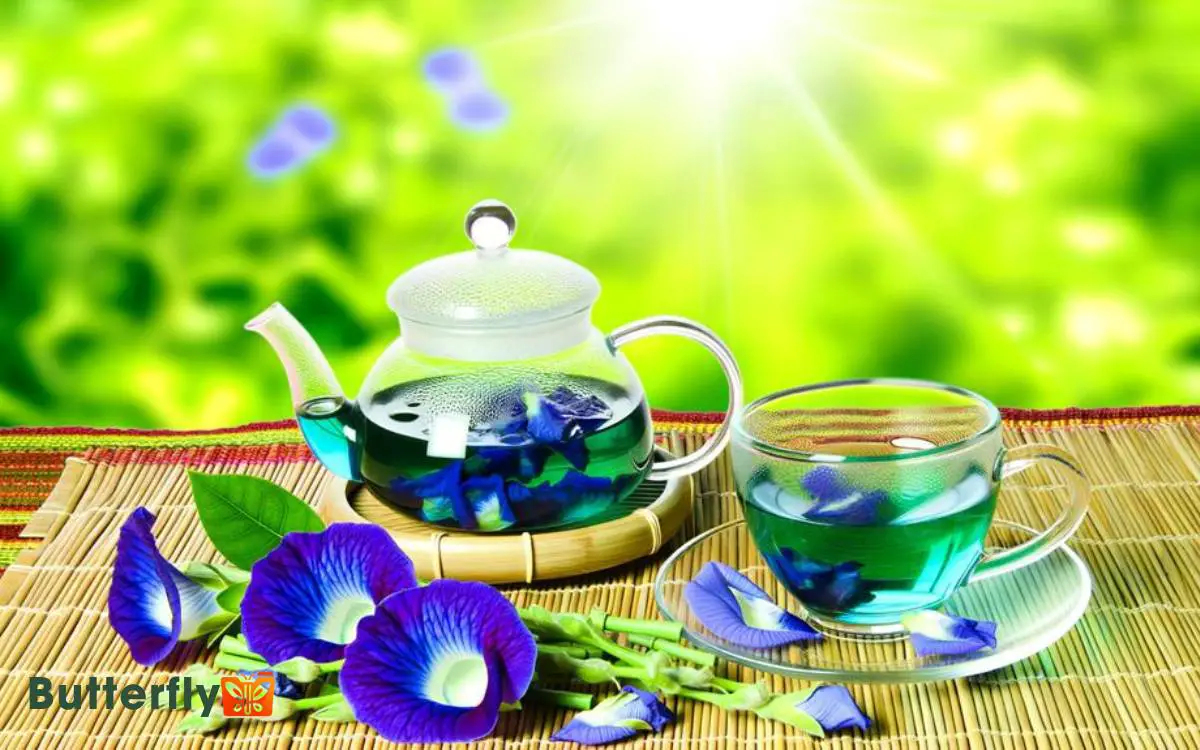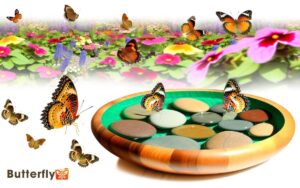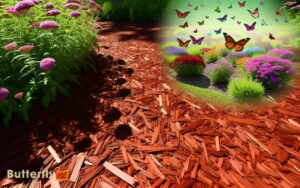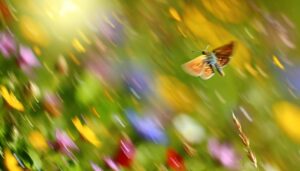Does Butterfly Pea Tea Have Caffeine? Discover the Answer!
It’s rich in antioxidants like anthocyanins, which combat chronic inflammation and support heart health. The tea also contains flavonoids and tannins, aiding in blood sugar and cholesterol control.
Butterfly pea tea is hydrating and non-dependency forming, suitable for all age groups without the jittery side effects of caffeinated beverages.
It boasts a unique flavor profile with earthy, floral notes and can be enjoyed with lemon or honey for added benefits. Explore further to uncover more fascinating details!

Key Takeaways
What Is Butterfly Pea Tea?
Butterfly pea tea, made from the vibrant blue petals of the Clitoria ternatea plant, is a caffeine-free herbal infusion known for its potential antioxidant properties.
This tea is rich in anthocyanins, compounds responsible for its distinct blue color and potential health benefits.
You’ll find that these antioxidants can help neutralize free radicals in your body, potentially reducing oxidative stress and inflammation.
Additionally, butterfly pea tea contains peptides that may support cognitive function by inhibiting enzymes linked to neurodegenerative diseases.
It’s also used for its potential to enhance skin health, thanks to its ability to promote collagen synthesis.
As a caffeine-free option, butterfly pea tea is suitable for those looking to avoid the stimulating effects of caffeine while still enjoying a soothing beverage.
Historical Background
Tracing its origins to Southeast Asia, butterfly pea tea has been traditionally utilized in various cultural practices and medicinal applications for centuries.
You’ll find this vibrant blue infusion playing a significant role in the following areas:
- Traditional Medicine: Utilized in Ayurveda and other traditional systems to support cognitive function and mood.
- Culinary Uses: Incorporated into regional dishes and drinks for its vivid color and subtle flavor.
- Ritualistic Practices: Employed in various ceremonies and rituals, symbolizing peace and prosperity.
- Dye Production: Used as a natural dye for textiles and food, leveraging its intense blue pigment.
- Cosmetic Applications: Included in beauty treatments for its purported skin-enhancing properties.
Understanding its historical context highlights the multifaceted utility of butterfly pea tea beyond its modern-day consumption.
Health Benefits
You’re likely to appreciate the health benefits of Butterfly Pea Tea, especially due to its high antioxidant content and potential cognitive enhancement. Research indicates that its rich anthocyanin compounds can neutralize free radicals, thereby reducing oxidative stress.
Additionally, preliminary studies suggest it may improve memory and brain function by promoting neurogenesis and reducing inflammation.
Antioxidant Properties
A wealth of research indicates that butterfly pea tea is rich in antioxidants, which play an essential role in neutralizing harmful free radicals in the body.
These antioxidants, including anthocyanins and catechins, can greatly enhance your overall health by mitigating oxidative stress.
Here’s what you need to know:
- Anthocyanins: Known for their anti-inflammatory properties, they help reduce chronic inflammation.
- Catechins: These compounds are effective in improving cardiovascular health by reducing LDL cholesterol levels.
- Flavonoids: Contribute to skin health by protecting against UV damage.
- Tannins: Assist in detoxifying the body and promoting liver health.
- Proanthocyanidins: Strengthen blood vessels and improve circulation.
Incorporating butterfly pea tea into your diet can offer numerous antioxidant benefits, supporting your body’s defense mechanisms.
Cognitive Enhancement
In recent studies, butterfly pea tea has shown promising effects on enhancing cognitive function and memory retention.
The active compounds in the tea, such as anthocyanins and proanthocyanidins, play an important role in neuroprotection. These compounds help increase acetylcholine levels, a neurotransmitter essential for learning and memory.
Additionally, butterfly pea tea’s antioxidative properties combat oxidative stress, which is known to impair cognitive functions. By reducing oxidative damage to brain cells, the tea promotes better neural health.
Clinical trials have also indicated that regular consumption of butterfly pea tea can improve attention span and mental clarity.
Preparation Methods
To prepare butterfly pea tea, start by steeping dried butterfly pea flowers in hot water for approximately 5-10 minutes to guarantee the extraction of its beneficial compounds. This method maximizes the bioavailability of the tea’s antioxidants and anthocyanins. The vibrant blue color of the tea can change to purple with the addition of acidic ingredients like lemon juice, making it a visually appealing drink. For those curious about how to make butterfly pea tea with added flavor, consider mixing it with honey or herbs like lemongrass for a refreshing twist. Enjoy it hot or cold, depending on your preference, and reap its potential health benefits.
For an ideal preparation, consider the following:
- Water Temperature: Use water heated to around 200°F (93°C) for best results.
- Flower Quantity: Use 1-2 teaspoons of dried flowers per cup.
- Steeping Duration: 5-10 minutes to ensure full flavor and nutrient extraction.
- Straining: Use a fine mesh strainer to remove flower residues.
- Optional Additives: Enhance with lemon or honey for additional health benefits.
This preparation method guarantees you obtain the maximum therapeutic potential of butterfly pea tea.
Flavor Profile
When you drink butterfly pea tea, you’ll notice its unique earthy and floral notes, which contribute to its distinct taste profile. Research indicates that these flavors are derived from specific antioxidants and phytochemicals present in the flower.
Additionally, the tea’s color-changing effects when mixed with acidic substances, like lemon juice, not only enhance its visual appeal but also indicate pH-dependent bioactive compounds.
Earthy and Floral Notes
Butterfly pea tea boasts an intricate flavor profile characterized by earthy and floral notes, offering a unique combination that enhances its health benefits. The tea’s taste can be attributed to anthocyanins, potent antioxidants that provide both flavor and health advantages.
When you sip this tea, you may notice:
- Earthy undertones: Reminiscent of fresh, damp soil, providing a grounding experience.
- Floral accents: Subtle hints of jasmine or lavender, adding a delicate sweetness.
- Mild bitterness: Balances the overall flavor, preventing it from being overly sweet.
- Umami: A savory component that enriches the taste profile.
- Refreshing finish: Leaves a clean, crisp sensation on your palate.
These elements create a complex, enjoyable beverage that supports well-being through its rich antioxidant content.
Color-Changing Effects
As you enjoy the intricate flavors of butterfly pea tea, you’ll be fascinated by its remarkable color-changing effects, which not only enhance its visual appeal but also indicate shifts in acidity that can subtly alter its taste profile.
When you add acidic substances like lemon juice, the tea’s pH level decreases, causing the deep blue liquid to transform into a vibrant purple or pink. This shift reflects a change in anthocyanin compounds, which are sensitive to pH variations.
These visual changes can also signify a slight alteration in flavor, rendering the tea a bit tangier. This dynamic interplay between visual and taste sensations makes butterfly pea tea an engaging choice for those interested in both aesthetics and nuanced flavor experiences.
Chemical Composition
You’ll find that the chemical composition of butterfly pea tea is rich in anthocyanins, particularly delphinidin, which contribute to its vibrant blue hue and potential health benefits. These anthocyanins are potent antioxidants that can support your body’s health in various ways.
The tea also contains other beneficial compounds:
- Flavonoids: Known for their anti-inflammatory and immune-boosting properties.
- Tannins: Compounds that can help in controlling blood sugar and cholesterol levels.
- Quercetin: A flavonoid that may provide cardio-protective effects.
- Kaempferol: Another flavonoid associated with reducing the risk of chronic diseases.
- Proanthocyanidins: These enhance the elasticity of blood vessels and improve circulation.
Caffeine Content
You’ll be pleased to know that butterfly pea tea is naturally caffeine-free, making it an excellent choice for those seeking a non-stimulant beverage.
This herbal tea offers numerous health benefits, such as antioxidant properties, without the jittery effects of caffeine.
When compared to other teas like green or black tea, it stands out as a soothing alternative for any time of day.
Naturally Caffeine-Free
Butterfly pea tea is naturally caffeine-free, making it a suitable option for those seeking a non-stimulant beverage. This characteristic provides several health-related benefits, especially for individuals who are sensitive to caffeine or looking to reduce their intake.
By incorporating butterfly pea tea into your routine, you can enjoy the following advantages:
- Reduced Anxiety: Absence of caffeine prevents jitteriness and promotes a calming effect.
- Improved Sleep Quality: Drinking it in the evening won’t interfere with your natural sleep cycle.
- Hydration: Enhances fluid intake without diuretic effects.
- Suitable for All Ages: Safe for children and adults alike.
- No Risk of Dependency: Eliminates the potential for caffeine-related dependency.
These points highlight why butterfly pea tea is an excellent choice for a caffeine-free lifestyle.
Herbal Tea Benefits
In addition, herbal teas, such as butterfly pea tea, offer numerous health benefits while being naturally caffeine-free, making them an excellent choice for those looking to avoid stimulants.
Without caffeine, these teas can be consumed at any time without disrupting sleep patterns. They are rich in antioxidants, which help combat oxidative stress and reduce inflammation.
Moreover, herbal teas often contain various phytochemicals that promote overall health.
| Herbal Tea | Caffeine Content | Key Benefits |
|---|---|---|
| Butterfly Pea Tea | 0 mg | Antioxidants, anti-inflammatory |
| Chamomile Tea | 0 mg | Calming, digestive aid |
| Peppermint Tea | 0 mg | Digestive health, headache relief |
Comparing With Other Teas
When comparing butterfly pea tea to other popular teas regarding caffeine content, you’ll find that black, green, and oolong teas contain varying amounts of caffeine that can affect energy levels and sleep patterns.
Butterfly pea tea, however, is naturally caffeine-free, making it an excellent option if you’re sensitive to caffeine or seek a relaxing beverage.
Here’s a quick comparison:
- Black tea: Contains approximately 40-70 mg of caffeine per cup.
- Green tea: Has about 20-45 mg of caffeine per cup.
- Oolong tea: Offers around 30-50 mg of caffeine per cup.
- Herbal teas: Generally caffeine-free, similar to butterfly pea tea.
- Butterfly pea tea: Completely caffeine-free.
Understanding these differences helps you make informed choices based on your caffeine tolerance and health goals.
Comparing With Other Teas
Comparing butterfly pea tea to other teas, you’ll find that it stands out because it naturally contains no caffeine, unlike traditional black or green teas. This makes it a suitable choice for those looking to avoid the stimulating effects of caffeine.
Studies indicate that caffeine-free beverages can help reduce anxiety and improve sleep quality. Additionally, butterfly pea tea offers unique antioxidants, particularly anthocyanins, which contribute to its vibrant blue color and potential health benefits.
In contrast, black and green teas provide catechins and theaflavins but also include caffeine, which some individuals may want to limit.
Opting for butterfly pea tea could support relaxation and provide antioxidant benefits without the jittery side effects associated with caffeinated teas.
Potential Side Effects
In order to make informed health decisions, it’s important to be aware of butterfly pea tea’s potential side effects despite its numerous benefits.
While generally considered safe, some individuals may experience adverse reactions. Understanding these possibilities helps you manage your health better.
- Gastrointestinal Discomfort: Some people report mild stomach upset or nausea.
- Allergic Reactions: Rare but possible, especially if you have plant allergies.
- Blood Sugar Levels: It may lower blood sugar, posing risks for diabetics on medication.
- Interactions with Medication: Consult your doctor if you’re on blood thinners or other drugs.
- Pregnancy and Breastfeeding: Insufficient evidence on safety; best to avoid unless approved by a healthcare provider.
Being mindful of these potential side effects ensures you enjoy butterfly pea tea safely and effectively.
Popular Recipes
Wondering how to incorporate butterfly pea tea into your daily routine? Here are some popular, health-focused recipes to get you started.
Here’s a quick reference table:
| Recipe | Ingredients | Benefits |
|---|---|---|
| Butterfly Pea Tea Lemonade | Butterfly pea tea, lemon, honey | Antioxidants, hydration |
| Butterfly Pea Tea Smoothie | Butterfly pea tea, fruits, protein | Nutrient-dense, energy-boosting |
| Butterfly Pea Tea Latte | Butterfly pea tea, milk, sweetener | Calming, stress-reducing |
These recipes can help you enjoy the numerous health benefits of butterfly pea tea effortlessly.
Conclusion
To sum up, while butterfly pea tea offers a myriad of health benefits like those from ancient elixirs, it stands out by being caffeine-free.
This makes it a stellar choice for anyone seeking a calming, antioxidant-rich beverage without the jitters associated with caffeine.
So, as you sip this vibrant blue tea, remember you’re indulging in a tradition that not only delights the senses but also supports your well-being in a uniquely soothing way.






